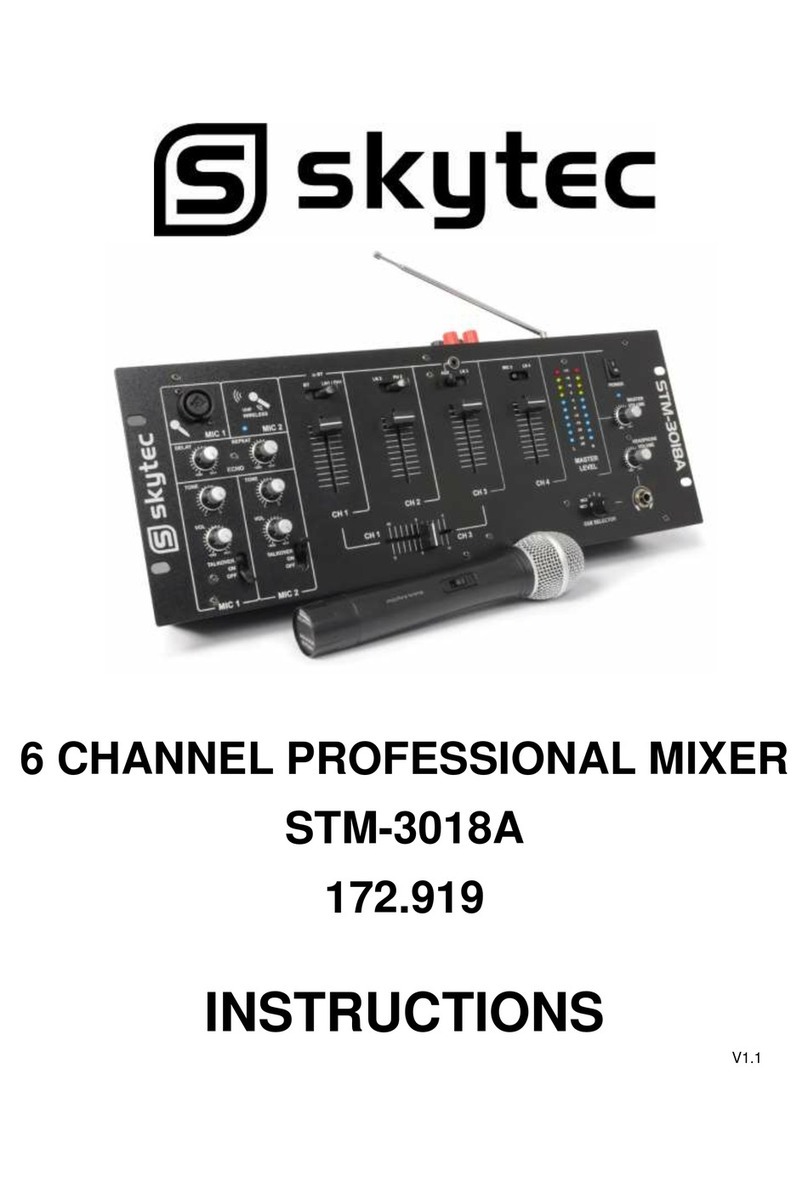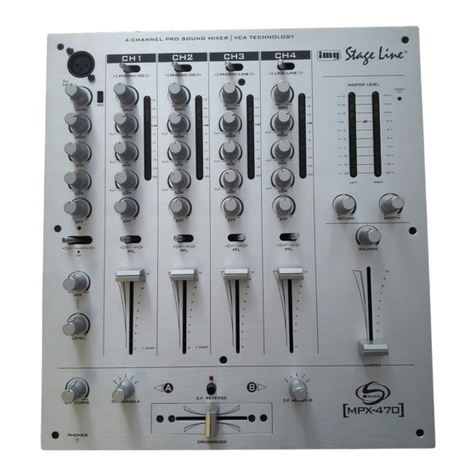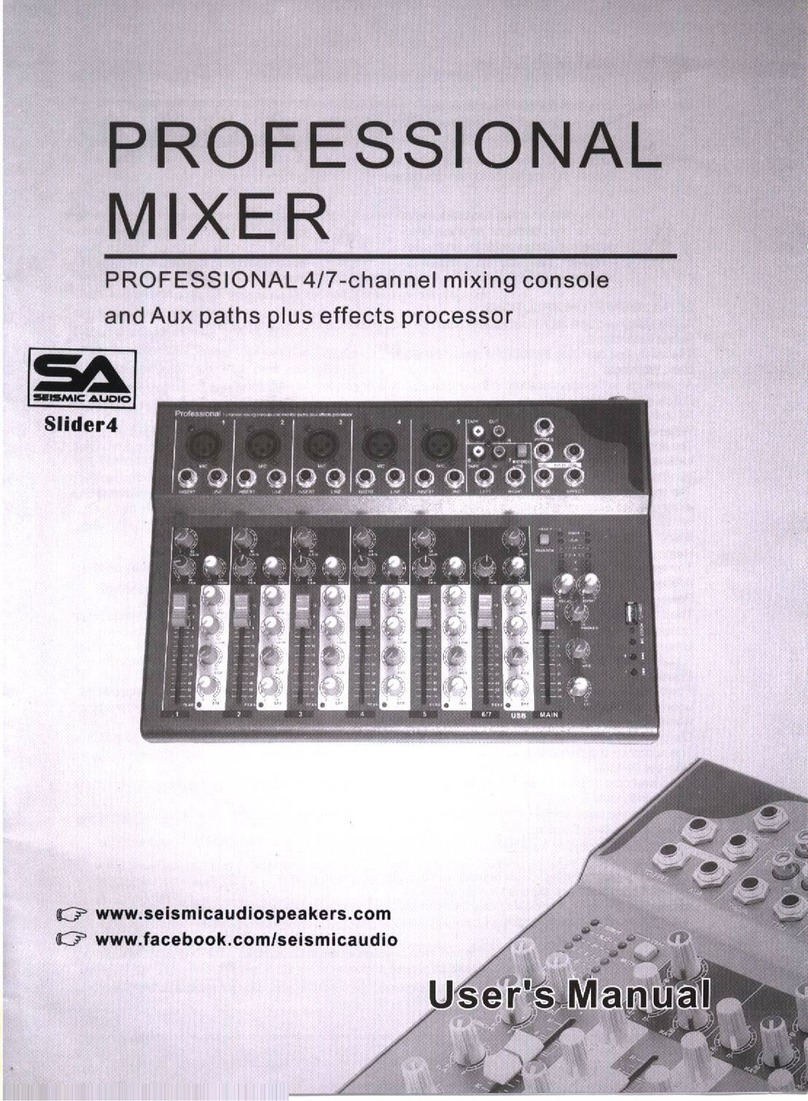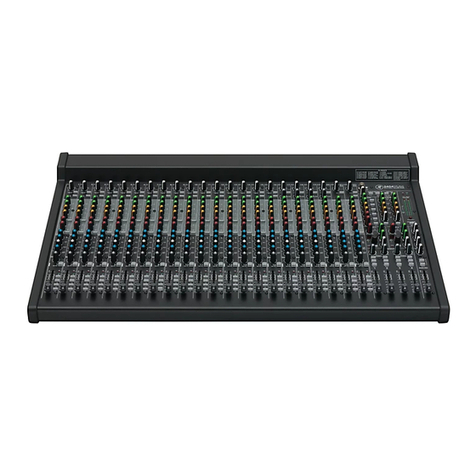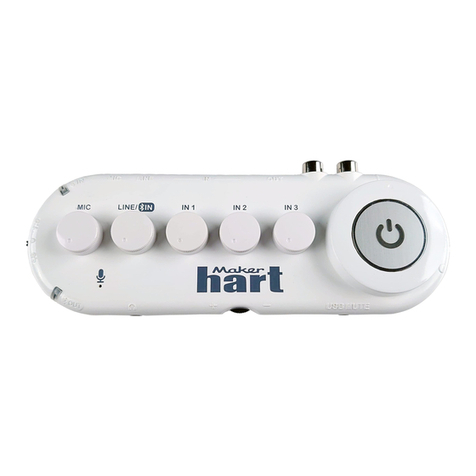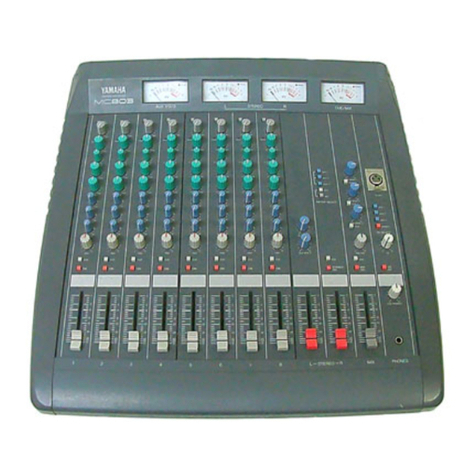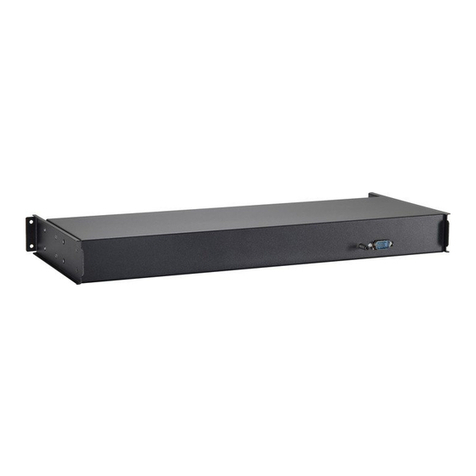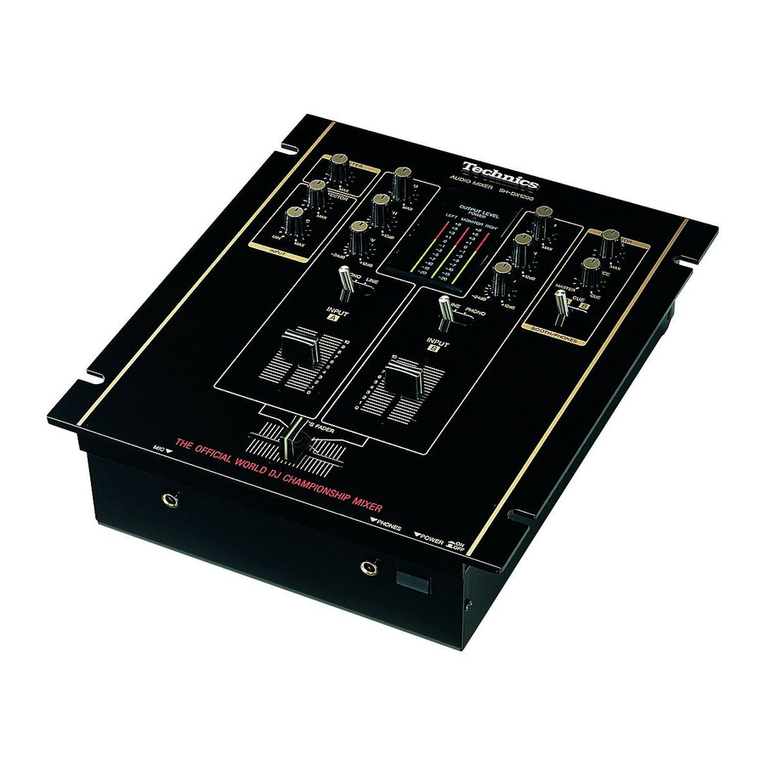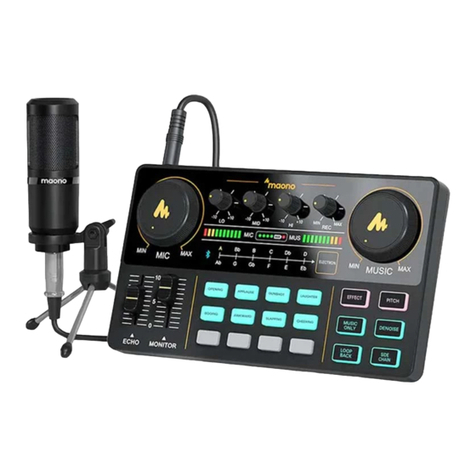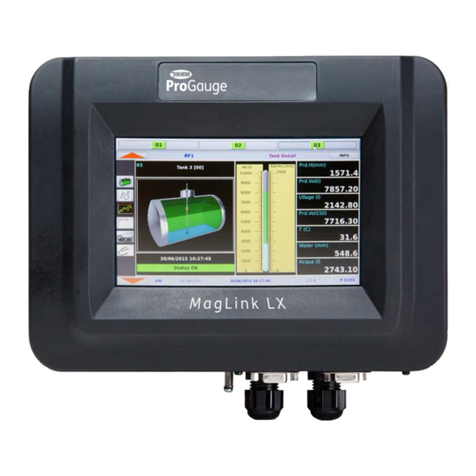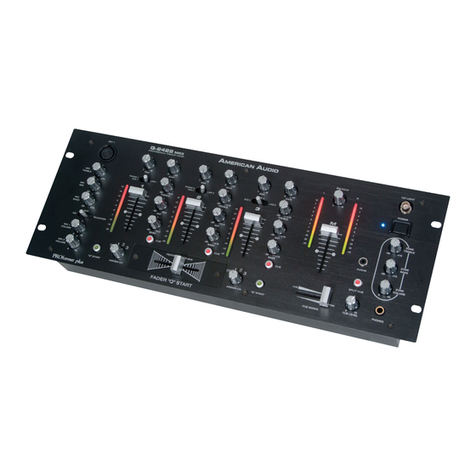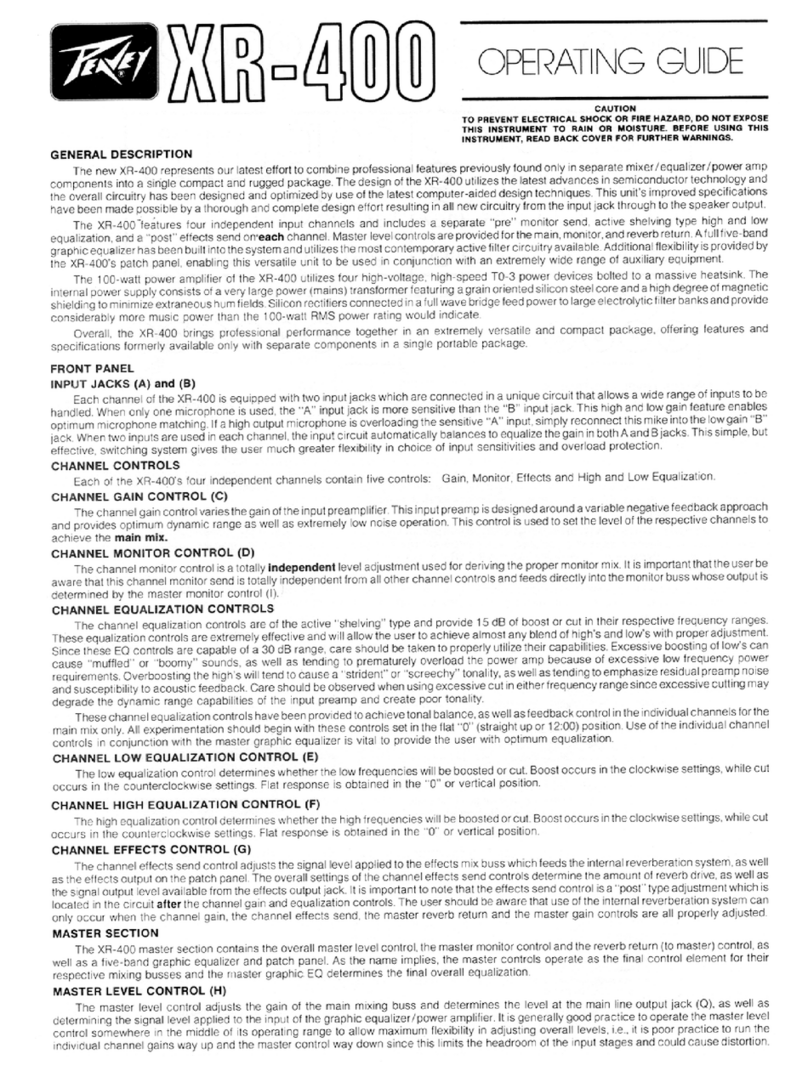IMG STAGE LINEgital MMX-602/SW User manual

BEDIENUNGSANLEITUNG • INSTRUCTION MANUAL • MODE D’EMPLOI • ISTRUZIONI PER L’USO
VEILIGHEIDSVOORSCHRIFTEN • CONSEJOS DE SEGURIDAD
SIKKERHEDSOPLYSNINGER • SÄKERHETSFÖRESKRIFTER • TURVALLISUUDESTA
6-KANAL-MIKROFON/LINE-MISCHPULT
6-CHANNEL MICROPHONE/LINE MIXER
MIXEUR MICRO/LIGNE 6 CANAUX
MIXER MICROFONO/LINE A 6 CANALI
MMX-602/SW Best.-Nr. 20.2230
ACTIVEON
10 |RL|0
SENS
010
CH1+2
CH1
OFF
ON LINE
MIC
10 |RL|0
LINE
MIC
10 |RL|0
LINE
MIC
10 |RL|0
LINE
MIC
10 |RL|0
LINE
MIC
10 |RL|0
LEVEL BAL LEVEL BAL LEVEL BAL LEVEL BAL LEVEL BAL LEVEL BAL
LINE
MIC
MID
–12 +12
dB
LOW
–12 +12
dB
HIGH
–12 +12
dB
LEFT / A
010
LEFT / B
010
LEVEL
010
POWER
PHONES
PRO 6-CHANNEL
MICROPHONE/
LINE MIXER
MMX-602/SW
1
CH 2
CH 3
CH 4
CH 5
CH 6
CH
TALKOVER EQUALIZER
–12 –6 –3 0 dB +3 –12 –6 –3 0 dB +3
STEREO
MONO
LL/A R/BRPEAK

2
wwwwww..iimmggssttaaggeelliinnee..ccoomm
Bevor Sie einschalten ...
Wir wünschen Ihnen viel Spaß mit Ihrem neuen Gerät
von „img Stage Line“. Dabei soll Ihnen diese Bedie-
nungsanleitung helfen, alle Funktionsmöglichkeiten
kennen zu lernen. Die Beachtung der Anleitung ver-
meidet außerdem Fehlbedienungen und schützt Sie und
Ihr Gerät vor eventuellen Schäden durch unsachge-
mäßen Gebrauch.
Den deutschen Text finden Sie auf den Seiten 4–7.
Before you switch on ...
We wish you much pleasure with your new unit by “img
Stage Line”. With these operating instructions you will be
able to get to know all functions of the unit. By following
these instructions false operations will be avoided, and
possible damage to you and your unit due to improper
use will be prevented.
You will find the English text on the pages 4–7.
D
A
CH
GB
Avant toute mise en service ...
Nous vous remercions d’avoir choisi un appareil “img
Stage Line” et vous souhaitons beaucoup de plaisir à
l’utiliser. Cette notice a pour objectif de vous aider à
mieux connaître les multiples facettes de l’appareil et à
vous éviter toute mauvaise manipulation.
La version française se trouve pages 8–11.
Prima di accendere ...
Vi auguriamo buon divertimento con il Vostro nuovo appa-
recchio “img Stage Line”. Le istruzioni per l’uso Vi pos-
sono aiutare a conoscere tutte le possibili funzioni. E
rispettando quanto spiegato nelle istruzioni, evitate di
commettere degli errori, e così proteggete Voi stessi, ma
anche l’apparecchio, da eventuali rischi per uso improprio.
Il testo italiano lo potete trovare alle pagine 8–11.
F
B
CH
I
Voordat u inschakelt ...
Wij wensen u veel plezier met uw nieuw toestel van “img
Stage Line”. Lees de veiligheidsvoorschriften, alvorens
het toestel in gebruik te nemen. Door de veiligheidsvoor-
schriften op te volgen zal een slechte werking vermeden
worden, en zal een eventueel letsel aan uzelf en schade
aan uw toestel tengevolge van onzorgvuldig gebruik
worden voorkomen.
U vindt de veiligheidsvoorschriften op pagina 12.
Antes de cualquier instalación ...
Tenemos de agradecerle el haber adquirido un equipo
de “img Stage Line” y le deseamos un agrable uso. Por
favor lee las instrucciones de seguridad antes del uso.
La observación de las instrucciones de seguridad evita
operaciones erróneas y protege Vd. y vuestro aparato
contra todo daño posible por cualquier uso inadecuado.
Las instrucciones de seguridad se encuentran en la
página 12.
NL
B
E
Inden De tænder for apparatet ...
Vi ønsker Dem god fornøjelse med Deres nye “img Stage
Line” apparat. Læs oplysningerne for en sikker brug af ap-
paratet før ibrugtagning. Følg sikkerhedsoplysningerne for
at undgå forkert betjening og for at beskytte Dem og
Deres apparat mod skade på grund af forkert brug.
Sikkerhedsoplysningerne finder De på side 12.
Förskrift
Vi önskar dig mycket nöje med din nya enhet från “img
Stage Line”. Läs gärna säkerhetsinstruktionerna innan
du använder enheten. Genom att följa säkerhetsinstruk-
tionerna kan många problem undvikas, vilket annars kan
skada enheten.
Du finner säkerhetsinstruktionerna på sidan 13.
DK S
Ennen virran kytkemistä…
Toivomme, että uusi “img Stage Line”-laitteesi tuo sinulle
paljon iloa ja hyötyä. Ole hyvä ja lue käyttöohjeet ennen
laitteen käyttöönottoa. Luettuasi käyttöohjeet voit käyt-
tää laitetta turvallisesti ja vältyt laitteen väärinkäytöltä.
Käyttöohjeet löydät sivulta 13.
FIN

3
➁
12 3 4 5
➀
L
R
LINE
1
23
MIC
MIC
AMP
+
–
V+
MIC
LINE BALANCE
LEVEL
PHANTOM
+12V
TALKOVER SENSITIVE
V+
ON
OFF
ACTIVE
ON
PEAK
PEAK
BASS MID TREBLE
TALKOVER
MONO
STEREO
REC L
REC R
1
2
3
+
–
LEFT/A
RIGHT/B
1
2
3
+
–
RIGHT/B
PHONES
LEFT/A
CH1
LEVEL PHONES
LEVEL
RIGHT/B
LEVEL
LEFT/A
VU-METER
CH1+2
CH1
JP101
MMX-602/SW
±12dB
±12dB
TALKOVER
➃
Blockschaltbild/Block diagram
Schéma bloc /Schema di connessione
ACTIVEON
POWER
PHONES
PRO 6-CHANNEL
MICROPHONE/
LINE MIXER
MMX-602/SW
1
CH 2
CH 3
CH 4
CH 5
CH 6
CH
TALKOVER EQUALIZER
LINE
MIC
MID
–12 +12
dB
10 |RL|0
LINE
MIC
10 |RL|0
LINE
MIC
10 |RL|0
LINE
MIC
10 |RL|0
10 |RL|0
SENS
010
CH1+2
CH1
OFF
ON LINE
MIC
10 |RL|0
LEVEL BAL LEVEL BAL LEVEL BAL LEVEL BAL LEVEL BAL LEVEL BAL
LINE
MIC
LOW
–12 +12
dB
HIGH
–12 +12
dB
LEFT / A
010
LEFT / B
010
LEVEL
010
–12 –6 –3 0dB +3 –12 –6 –3 0dB +3
STEREO
MONO
LL/A R/BRPEAK
67 8 9 10 11 12 13 14 15 16 17
PUSH PUSH PUSH PUSH PUSH PUSH
L/A R/B REC
OUTPUT
R/B
L/A
CH 6
MIC LINE
CH 5
LINE MIC
CH 4
MIC LINE
CH 3
LINE MIC
CH 2
MIC LINE
CH 1
LINE MIC
230V~/50Hz
MAINS
18 19 20 21 22 23
JP101
JP201
JP301
CH1 CH3CH2
JP401
JP501
CH5
JP601
CH6CH4
CH1 – JP101
CH2 – JP201
.....
CH6 – JP601
Aus
Off
Arrêt
Ein
On
Marche
12-V-Phantomspeisung
12 V phantom power
Alimentation fantôme 12 V
Alimentazione phantom 12 V
➂

Bitte klappen Sie die Seite 3 heraus. Sie sehen
dann immer die beschriebenen Bedienelemente
und Anschlüsse.
1Übersicht der Bedienelemente und
Anschlüsse
1.1 Frontseite (Abb. 1)
1Anzeige ON
leuchtet bei eingeschalteter Talkover-Funktion,
siehe Position 7 Taste OFF/ON
2Anzeige ACTIVE
leuchtet, wenn über die Talkover-Funktion die
Kanäle CH2–CH 6 bzw. CH3–CH6 automa-
tisch in der Lautstärke um 12dB abgesenkt sind
3Übersteuerungsanzeige PEAK
bei Aufleuchten den entsprechenden Kanal-
pegelregler LEVEL (9) zurückdrehen
4Pegelanzeige (2 x 5 LEDs) für dieAusgänge (19)
und (20)
5Betriebsanzeige
6Regler SENS für die Ansprechschwelle der Talk-
over-Funktion
7Taste OFF/ON zum Ein-/Ausschalten der Talk-
over-Funktion
8Umschalter CH1+2/CH1 zum Zuweisen der
Talkover-Funktion
Taste gedrückt: Liegt ein Line-Signal an Kanal
CH1 an oder erfolgt eine Mikro-
fondurchsage über Kanal CH1,
werden zur besseren Verständ-
lichkeit die Kanäle CH2 bis
CH6 in der Lautstärke um 12dB
abgesenkt
nicht gedrückt: Liegt ein Line-Signal an Kanal
CH1 oder CH2 an oder erfolgt
eine Mikrofondurchsage über
CH1 oder CH2, werden die Ka-
näle CH3 bis CH6 abgesenkt
9vorderer Drehknopf LEVEL, jeweils für die
Kanäle CH1 bis CH6:
zum Einstellen des Kanalpegels
10 hinterer Drehring BAL, jeweils für die Kanäle
CH1 bis CH6:
zur Balance-Einstellung der Line-Eingänge (22)
bzw. um ein Mikrofonsignal auf die gewünschte
Stelle in der Stereo-Basis zu legen
11 Eingangswahlschalter, jeweils für die Kanäle
CH1 bis CH6
Taste gedrückt: Der Mikrofoneingang über die
XLR-Buchse (23) ist angewählt
nicht gedrückt: Der Line-Eingang über die Cinch-
Buchsen (22) ist angewählt
12 Klangregler für alle Ausgänge (19, 20, 21)
LOW = Bassregler
MID = Mittenregler
HIGH = Höhenregler
13 Umschalter STEREO/MONO für den Betriebs-
modus [nur für die Ausgänge (19) und (20) wirk-
sam]
Taste gedrückt: Mono-Betrieb
nicht gedrückt: Stereo-Betrieb
14 Pegelregler für die Ausgänge (19) und (20)
15 Lautstärkeregler LEVEL für einen an der Buchse
PHONES (16) angeschlossenen Kopfhörer
16 6,3-mm-Klinkenbuchse PHONES zumAnschluss
eines Kopfhörers (Impedanz mindestens 2 x 8Ω)
17 Ein-/Ausschalter POWER
1.2 Rückseite (Abb. 2)
18 Netzkabel zum Anschluss an eine Steckdose
(230V~/50Hz)
19 XLR-Ausgang, symmetrisch, mono oder stereo
in Abhängigkeit vom Umschalter (13)
20 Cinch-Ausgang, asymmetrisch, mono oder
stereo in Abhängigkeit vom Umschalter (13)
21 Aufnahme-Ausgang REC (stereo, Cinch-Buch-
sen, asym.); dieAufnahmelautstärke ist von Stel-
lung der Ausgangsregler (14) unabhängig
22 Stereo-Eingang LINE für Geräte mit Line-Aus-
gang, z.B. CD-Spieler, Tape-Deck, Tuner usw.,
jeweils für die Kanäle CH1 bis CH6
(Cinch-Buchsen, asym.)
23 Mikrofon-Eingang MIC, jeweils für die Kanäle
CH1 bis CH6 (XLR, symmetrisch)
1.3 Ausschnitt Innenansicht (Abb. 3)
Die Abbildung 3 zeigt die Lage der Steckbrücken
JP101 bis JP601 (Blick von oben, Geräteabdeckung
abgenommen). Mit den Brücken lässt sich eine 12-V-
Phantomspeisung für jeden Mikrofoneingang ge-
trennt dazuschalten. Bei Auslieferung ab Werk ist
die Phantomspeisung ausgeschaltet. Detaillierte
Beschreibung siehe im Kapitel 4.1.
2Hinweise für den sicheren Gebrauch
Dieses Gerät entspricht der Richtlinie für elektro-
magnetische Verträglichkeit 89/336/EWG und der
Niederspannungsrichtlinie 73/23/EWG.
Beachten Sie auch unbedingt die folgenden Punkte:
●Verwenden Sie das Gerät nur im Innenbereich.
Schützen Sie es vor Tropf- und Spritzwasser,
hoher Luftfeuchtigkeit und Hitze (zulässiger Ein-
satztemperaturbereich 0–40°C).
●Stellen Sie keine mit Flüssigkeit gefüllten Gefäße,
z.B. Trinkgläser, auf das Gerät.
Achtung! Das Gerät wird mit lebensgefährlicher
Netzspannung (230V~) versorgt. Neh-
men Sie deshalb nie selbst Eingriffe am
Gerät vor. Durch unsachgemäßes Vor-
gehen besteht die Gefahr eines elektri-
schen Schlages. Außerdem erlischt
beim Öffnen des Gerätes jeglicher
Garantieanspruch.
Achtung! Zum Zuschalten der Phantomspeisung
muss das Mischpult geöffnet werden.
Darum darf dies nur durch eine qualifi-
zierte Fachkraft erfolgen.
Please unfold page 3. Then you can always see
the operating elements and connections de-
scribed.
1Operating Elements and Connections
1.1 Front panel (fig. 1)
1Indication ON
lights up with the talkover function switched on,
see item 7 button OFF/ON
2Indication ACTIVE
lights up if the volume of channels CH2 to CH6
or CH3 to CH6 is automatically attenuated by
12dB via the talkover function
3Overload indication PEAK
if it lights up, turn back the corresponding chan-
nel level control LEVEL (9)
4Level indication (2 x 5 LEDs) for the outputs (19)
and (20)
5Power indication
6Control SENS for the threshold of the talkover
function
7Button OFF/ON for switching the talkover func-
tion on and off
8Selector switch CH1+2/CH1 to assign the talk-
over function
Button pressed: if a line signal is present at
channel CH1 or if a microphone
announcement is made via
channel CH1, the volume of
channels CH2 to CH6 is
attenuated by 12dB for better
audibility
not pressed: if a line signal is present at chan-
nel CH1 or CH2 or if a micro-
phone announcement is made
via channel CH1 or CH2, chan-
nels CH3 to CH6 are atten-
uated
9Front rotary knob LEVEL, each for channels
CH1 to CH6:
to adjust the channel level
10 Rear rotary ring BAL, each for channels CH1 to
CH6:
to adjust the balance of the line inputs (22) or to
place a microphone signal to the desired spot in
the stereo basis
11 Input selector switch, each for channels CH1 to
CH6
Button pressed: the microphone input is select-
ed via the XLR jack (23)
not pressed: the line input is selected via the
phono jacks (22)
12 Equalizer for all outputs (19, 20, 21)
LOW = bass range control
MID = midrange control
HIGH = high range control
13 Selector switch STEREO/MONO for the ope-
rating mode [only effective for the outputs (19)
and (20)]
Button pressed: mono operation
not pressed: stereo operation
14 Level controls for the outputs (19) and (20)
15 Volume control LEVEL for headphones con-
nected to the jack PHONES (16)
16 6.3mm jack PHONES to connect headphones
(impedance 2 x 8Ωminimum)
17 POWER switch
1.2 Rear panel (fig. 2)
18 Mains cable for connection to a mains socket
(230V~/50Hz)
19 XLR output, balanced, mono or stereo depend-
ing on the selector switch (13)
20 Phono output, unbalanced, mono or stereo
depending on the selector switch (13)
21 Recording output REC (stereo, phono jacks,
unbal.); the recording volume is independent of
the position of the output level controls (14)
22 Stereo input LINE for units with line output, e.g.
CD player, tape deck, tuner, etc., each for chan-
nels CH1 to CH6 (phono jacks, unbal.)
23 Microphone input MIC, each for channels CH1
to CH6 (XLR, balanced)
1.3 Cutout of interior view (fig. 3)
Fig. 3 shows the position of the jumpers JP101 to
JP601 (view from above, the cover of the unit is re-
moved). With the jumpers it is possible to switch on a
12V phantom power separately for each microphone
input. Upon delivery ex factory, the phantom power is
switched off. For detailed description see chapter 4.1.
2Safety Notes
The unit corresponds to the directive for electro-
magnetic compatibility 89/336/EEC and to the low
voltage directive 73/23/EEC.
The following items must be observed in any case:
●The unit is suitable for indoor use only. Protect it
against dripping water and splash water, high
humidity, and heat (ambient temperature range
0–40°C).
●Do not place any vessels filled with liquid,
e.g. drinking glasses, on the unit.
Attention! The unit is supplied with hazardous
mains voltage (230V~). Leave ser-
vicing to skilled personnel only. In-
expert handling may cause an electric
shock hazard. Furthermore, any guar-
antee claim will expire if the unit has
been opened.
Attention!To switch on the phantom power, the
mixer must be opened. For this reason
this must only be done by qualified per-
sonnel.
4
GB
D
A
CH

●Nehmen Sie das Gerät nicht in Betrieb bzw. zie-
hen Sie sofort den Netzstecker aus der Steck-
dose, wenn:
1. sichtbare Schäden am Gerät oder an der Netz-
anschlussleitung vorhanden sind,
2. nach einem Sturz oder Ähnlichem der Verdacht
auf einen Defekt besteht,
3. Funktionsstörungen auftreten.
Lassen Sie das Gerät in jedem Fall in einer Fach-
werkstatt reparieren.
●Eine beschädigte Netzanschlussleitung darf nur
durch den Hersteller oder eine autorisierte Fach-
werkstatt ersetzt werden.
●Ziehen Sie den Netzstecker nie am Kabel aus der
Steckdose, fassen Sie immer am Stecker an.
●Für die Reinigung nur ein trockenes, weiches
Tuch verwenden, auf keinen Fall Chemikalien
oder Wasser.
●Wird das Gerät zweckentfremdet, falsch ange-
schlossen bzw. bedient oder nicht fachgerecht re-
pariert, kann keine Haftung für daraus resultie-
rende Sach- oder Personenschäden und keine
Garantie für das Gerät übernommen werden.
3Einsatz- und Aufstellmöglichkeiten
Mit diesem 6-Kanal-Mischpult lassen sich Geräte
mit Line-Ausgang (z.B. CD-Spieler, Tape-Deck,
Tuner) und Mikrofone (auch phantomgespeiste) auf
einen Stereo- oder Mono-Ausgangskanal mischen.
Der MMX-602/SW eignet sich dadurch z.B. als Vor-
mischer für eine Mikrofongruppe (Chor, Schlagzeug
usw.) oder als Mischpult in Beschallungsanlagen.
Das Gerät ist für die Montage in ein Rack
(482mm/19") vorgesehen, kann aber auch als frei-
stehendes Tischgerät verwendet werden. Für den
Einbau in ein Rack wird 1HE (Höheneinheit) =
44,45mm benötigt.
Hinweis: Werden phantomgespeiste Mikrofone an-
geschlossen, muss vor dem Einbau in ein Rack die
Phantomspeisung dazugeschaltet werden (siehe
Kapitel 4.1).
4Gerät anschließen
Vor demAnschluss bzw. vor dem Verändern vonAn-
schlüssen das Mischpult und die anzuschließenden
Geräte ausschalten.
Soll die Talkover-Funktion (siehe Kapitel 5.3) ge-
nutzt werden, bei der Belegung der Kanäle beach-
ten, dass ein Signal auf Kanal CH1 oder CH2 die
Lautstärke der Kanäle CH2–CH6 bzw. CH3–CH6
verringern kann. Beispiel: Kanäle CH1 und CH2 für
die Mikrofone der Sprecher oder Akteure, die übri-
gen Kanäle für das Begleitprogramm oder die
Hintergrundmusik.
1) Geräte mit Line-Pegel (z.B. CD-Spieler, Tape-
Deck, Tuner usw.) an die sechs Cinch-Buchsen-
paare LINE (22) anschließen:
weiße Buchse LEFT = linker Kanal
rote Buchse RICHT = rechter Kanal
2) Mikrofone (symmetrisch oder asymmetrisch) an
die sechs XLR-Buchsen MIC (23) anschließen.
Für phantomgespeiste Mikrofone die Phantom-
speisung dazuschalten – siehe Kapitel 4.1.
Soll ein Mikrofonstecker wieder aus dem Misch-
pult herausgezogen werden, zur Entriegelung die
Taste PUSH der XLR-Buchse drücken.
3) Den Endverstärker für die Lautsprecher oder
ein nachfolgendes Gerät mit Line-Eingang
(Hauptmischpult, Effektgerät etc.) an die passen-
den Ausgangsbuchsen anschließen:
ein Gerät mit XLR-Eingang an die XLR-Buchsen
L/Aund R/B (19) und/oder
ein Gerät mit Cinch-Eingang an die Cinch-Buch-
sen L/A und R/B (20)
4) Ein Aufnahmegerät für Tonaufnahmen kann an
die Cinch-Buchsen REC (21) angeschlossen wer-
den. Die Aufnahmelautstärke ist unabhängig von
der Einstellung der Ausgangspegelregler (14).
Die Aufzeichnung erfolgt unabhängig von der
Stellung des Schalters STEREO/MONO (13),
d.h. immer stereofon.
5) Über einen Kopfhörer lässt sich dasAusgangssi-
gnal des Mischpultes abhören. Dazu einen Kopf-
hörer (Impedanz minimal 2 x 8Ω) an die 6,3-mm-
Klinkenbuchse PHONES (16) anschließen.
6) Zuletzt den Netzstecker desAnschlusskabels (18)
in eine Steckdose (230V~/50Hz) stecken.
4.1 Mikrofon-Phantomspeisung dazuschalten
Um auch phantomgespeiste Mikrofone betreiben zu
können, lässt sich für jeden Mikrofoneingang ge-
trennt eine 12-V-Phantomspeisung dazuschalten.
1) Den Netzstecker aus der Steckdose ziehen.
2) Den Gehäusedeckel abschrauben.
3) Für die gewünschten Mikrofoneingänge die ent-
sprechenden Steckbrücken JP101 (für Kanal
CH1) bis JP601 (für Kanal CH6) von Aus nach
Ein, wie in Abb. 3 dargestellt, umstecken.
4) Den Gehäusedeckel wieder festschrauben.
Achtung! Zum Zuschalten der Phantomspeisung
muss das Mischpult geöffnet werden.
Darum darf dies nur durch eine qualifi-
zierte Fachkraft erfolgen.
Vorsicht! Ist die Phantomspeisung dazuge-
schaltet, dürfen keine asymmetri-
schen Mikrofone an den entspre-
chenden Kanälen angeschlossen
werden. Anderenfalls können diese
Mikrofone beschädigt werden.
Soll das Gerät endgültig aus dem Be-
trieb genommen werden, übergeben Sie
es zur umweltgerechten Entsorgung
einem örtlichen Recyclingbetrieb.
●Do not operate unit or immediately disconnect the
plug from the mains socket
1. if there is visible damage to the unit or to the
mains cable,
2. if a defect might have occurred after the unit
was dropped or suffered a similar accident,
3. if malfunctions occur.
In any case the unit must be repaired by skilled
personnel.
●Adamaged mains cable must only be repaired by
the manufacturer or authorized skilled personnel.
●Never pull the mains cable to disconnect the mains
plug from the mains socket, always seize the plug.
●Use a dry dust cloth only for cleaning, by no
means chemicals or water.
●No guarantee claims for the unit and no liability for
any resulting personal damage or material dam-
age will be accepted if the unit is used for other
purposes than originally intended, if it is not cor-
rectly connected, operated, or not repaired in an
expert way.
●Important for U.K. Customers!
The wires in this mains lead are coloured in ac-
cordance with the following code:
blue = neutral
brown = live
As the colours of the wires in the mains lead of this
appliance may not correspond with the coloured
markings identifying the terminals in your plug,
proceed as follows:
1. The wire which is coloured blue must be con-
nected to the terminal which is marked with the
letter Nor coloured black.
2. The wire which is coloured brown must be con-
nected to the terminal which is marked with the
letter Lor coloured red.
3Applications and Setting-up
With this 6-channel mixer it is possible to mix units
with line output (e.g. CD player, tape deck, tuner)
and microphones (also phantom-powered) to a ster-
eo or mono output channel. Thus, the MMX-602/SW
is suitable e.g. as pre-mixer for a microphone group
(chorus, drums, etc.) or as mixer in PA systems.
The unit is provided for mounting into a rack
(482mm/19"), but it can also be used as a table top
unit. For the installation into a rack 1 rack space =
44.45mm is required.
Note: if phantom-powered microphones are con-
nected, the phantom power must be switched on
prior to the rack installation (see chapter 4.1).
4Connection of the Unit
Prior to the connection or changing of connections,
switch off the mixer and the units to be connected.
For using the talkover function (see chapter 5.3),
when connecting the channels observe that a signal
on channel CH1 or CH2 can change the volume of
channels CH2 to CH6 or CH3 to CH6. Example:
CH1 and CH2 for the microphones of speaking or
acting persons, the remaining channels for the
accompanying programme or the background
music.
1) Connect units with line level (e.g. CD player,
tape deck, tuner, etc.) to the six pairs of phono
jacks LINE (22):
white jack LEFT = left channel
red jack RIGHT = right channel
2) Connect microphones (balanced or unbalanced)
to the six XLR jacks MIC (23). For phantom-
powered microphones switch on the phantom
power – see chapter 4.1.
For disconnecting a microphone plug from the
mixer, press the button PUSH of the XLR jack for
unlocking.
3) Connect the power amplifier for the speakers or
a subsequent unit with line input (main mixer,
effect unit, etc.) to the matching output jacks:
a unit with XLR input to the XLR jacks L/A and
R/B (19) and/or
a unit with phono input to the phono jacks L/A
and R/B (20)
4) A recording unit for audio recordings can be
connected to the phono jacks REC (21). The re-
cording volume is independent of the adjustment
of the output level controls (14). The recording is
made independent of the position of switch
STEREO/MONO (13), i.e. it is always stereo-
phonic.
5) Via headphones it is possible to monitor the out-
put signal of the mixer. For this purpose connect
headphones (minimum impedance 2 x 8Ω) to the
6.3 mm jack PHONES (16).
6) Finally connect the mains plug of the cable (18)
to a mains socket (230V~/50Hz).
4.1 Switching on the microphone phantom
power
To be able to operate phantom-powered microphones
as well, it is possible to switch on a 12V phantom
power separately for each microphone input.
1) Disconnect the mains plug from the mains socket.
2) Screw off the housing cover.
3) For the desired microphone inputs rearrange the
corresponding jumpers JP101 (for channel CH1)
to JP601 (for channel CH6) from Off to On, as
shown in fig. 3.
4) Tightly screw on the housing cover again.
Attention! To switch on the phantom power, the
mixer must be opened. For this reason
this must only be done by qualified per-
sonnel.
Caution! If the phantom power is switched on,
no unbalanced microphones must
be connected to the corresponding
channels. Otherwise these micro-
phones may be damaged.
If the unit is to be put out of operation
definitively, take it to a local recycling
plant for disposal which is not harmful to
the environment.
5
GB
D
A
CH

5Bedienung
1) Vor dem Einschalten sollten die Ausgangspegel-
regler (14) auf Null gestellt werden, um eventu-
elle Einschaltgeräusche zu vermeiden.
2) Das Gerät mit dem Ein-/Ausschalter POWER (17)
einschalten. Die rote Betriebsanzeige (5) leuchtet.
3) Die angeschlossenen Geräte einschalten, zuletzt
immer den Endverstärker für die Lautsprecher.
4) Beim Ausschalten der Anlage immer zuerst den
Endverstärker abschalten.
5.1 Grundeinstellung der Eingangskanäle
1) Zuerst die sechs Kanalpegelregler LEVEL [vorde-
rer Drehknopf (9)] auf Null und die sechs Balan-
ceregler BAL [hinterer Drehring (10)] in die Mittel-
position stellen. Die Klangregler LOW, MID und
HIGH (12) ebenfalls in die Mittelposition drehen.
2) Für jeden Kanal mit dem Eingangswahlschalter
LINE/MIC (11) den gewünschten Eingang an-
wählen:
Taste gedrückt: Der Mikrofoneingang über die
XLR-Buchse (23) ist angewählt
nicht gedrückt: Der Line-Eingang über die Cinch-
Buchsen (22) ist angewählt
3) Mit dem Umschalter STEREO/MONO (13) den
Betriebsmodus wählen:
Taste gedrückt: Mono-Betrieb; es stehen die
Mono-Ausgangskänale A und B
mit gleichem Mischsignal zur
Verfügung
nicht gedrückt: Stereo-Betrieb; es steht ein
Stereo-Ausgangskanal LEFT/
RIGHT zur Verfügung
5.2 Mischen der Tonquellen
1) Die Talkover-Funktion vorerst nicht einschalten,
d.h. die Taste OFF/ON (7) darf nicht gedrückt
sein.
2) Auf alle angeschlossenen Eingänge ein Signal
geben (Testsignal, Musikstück oder Mikrofon-
durchsage).
3) Damit über den Ausgang ein Signal zu hören ist,
die Ausgangspegelregler LEFT/A und RIGHT/B
(14) vorerst ungefähr in die Position 7 drehen.
4) Den vorderen Drehknopf LEVEL (9) des Kanals
oder der Kanäle, die am lautesten zu hören sein
sollen, soweit aufdrehen, bis die Anzeige PEAK
(3) bei den lautesten Passagen kurz aufleuchtet.
Den oder die Regler wieder etwas zurückdrehen.
5) Die übrigen Kanäle, die ebenfalls zu hören sein
sollen, mit den zugehörigen Drehknöpfen LEVEL
entsprechend dazumischen.
6) Arbeitet der MMX-602/SW im Stereo-Betrieb
[Taste STEREO/MONO (13) nicht gedrückt], für
jeden Kanal mit dem hinteren Drehring BAL (10)
entweder die Balance des Stereo-Signals von
den Cinch-Buchsen einstellen oder das
Mikrofonsignal auf die gewünschte Stelle in der
Stereo-Basis legen.
7) Den Klang mit den Reglern (14) einstellen:
LOW für die Bässe
MID für die Mitten
HIGH für die Höhen
8) Den Ausgangspegel mit den Reglern LEFT/Aund
RIGHT/B (14) so einstellen, dass bei den laute-
sten Passagen die gelben 0-dB-LEDs der Pegel-
anzeige (4) aufleuchten. Wird der Eingang des
nachfolgenden Gerätes (Verstärker, Mischpult)
dadurch jedoch übersteuert, die Regler entspre-
chend zurückdrehen.
Im Stereo-Betrieb mit denAusgangspegelreg-
lern (14) gleichzeitig die Balance des Misch-
signals einstellen. Im Mono-Betrieb können für
dieAusgänge Aund B unterschiedliche Pegel mit
den Reglern eingestellt werden.
5.3 Talkover-Funktion
Mit der Talkover-Funktion lässt sich die Verständ-
lichkeit z.B. einer Durchsage über Kanal CH1 oder
CH2 verbessern, indem während der Durchsage
automatisch die Lautstärke der anderen Kanäle um
12dB reduziert wird.
1) Die Talkover-Funktion mit der Taste OFF/ON (7)
einschalten. Zur Kontrolle leuchtet die Anzeige
ON (1).
2) Mit dem Umschalter CH1+2/CH1 wählen,
durch welche Kanäle die anderen Kanäle in der
Lautstärke verringert werden sollen:
Taste gedrückt: Liegt ein Line-Signal an Kanal
CH1 an oder erfolgt eine Mikro-
fondurchsage über Kanal CH1,
werden die Kanäle CH2 bis
CH6 in der Lautstärke verringert
nicht gedrückt: Liegt ein Line-Signal an Kanal
CH1 oder CH2 an oder erfolgt
eine Mikrofondurchsage über
einen dieser Kanäle, werden die
Kanäle CH3 bis CH6 abgesenkt
3) Ein Signal auf Kanal CH1 bzw. CH2 geben (z.B.
eine Durchsage über Mikrofon) und den Regler
SENS (6) soweit aufdrehen, bis die Anzeige
ACTIVE (2) während der Durchsage aufleuchtet.
Die Anzeige ACTIVE leuchtet immer dann, wenn
die entsprechenden Kanäle abgesenkt sind.
Hinweis: Wird der Regler SENS zu weit aufge-
dreht, kann die Lautstärkeabsenkung schon
durch Störgeräusche ausgelöst werden. Ist der
Regler nicht weit genug aufgedreht, erfolgt gar
keine Lautstärkeabsenkung oder nur bei lauten
Signalen.
5Operation
1) Prior to switching on, the output level controls
(14) should be set to zero to avoid a possible
switching-on noise.
2) Switch on the unit with the POWER switch (17).
The red power indication (5) lights up.
3) Switch on the connected units, always switch on
the power amplifier for the speakers last of all.
4) When switching off the system, always switch off
the power amplifier first.
5.1 Basic setting of the input channels
1) First set the six channel level controls LEVEL
[front rotary knob (9)] to zero and the six balance
controls BAL [rear rotary ring (10)] to mid-posi-
tion. Set the equalizer controls LOW, MID, and
HIGH (12) likewise to mid-position.
2) Select the desired input for each channel with the
input selector switch LINE/MIC (11):
Button pressed: the microphone input is selected
via the XLR jack (23)
not pressed: the line input is selected via the
phono jacks (22)
3) Select the operating mode with the selector
switch STEREO/MONO (13):
Button pressed: mono operation; the mono out-
put channelsA and B are availa-
ble with the same mixing signal
not pressed: stereo operation; a stereo out-
put channel LEFT/RIGHT is
available
5.2 Mixing of the audio sources
1) Do not switch on the talkover function for the time
being, i.e. the button OFF/ON (7) must not be
pressed.
2) Feed a signal to all connected inputs (test signal,
music piece, or microphone announcement).
3) To be able to hear a signal via the output, turn the
output level controls LEFT/A and RIGHT/B (14)
approx. to position 7 for the time being.
4) Turn up the front rotary knob LEVEL (9) of the
channel(s), which are to be heard at highest
volume, until the indication PEAK (3) shortly
lights up with the music peaks. Slightly turn back
again the control(s).
5) Add the remaining channels which are to be
heard as well with the corresponding rotary
knobs LEVEL accordingly.
6) If the MMX-602/SW is in stereo operation [button
STEREO/MONO (13) not pressed], adjust for
each channel with the rear rotary ring BAL (10)
either the balance of the stereo signal of the
phono jacks or apply the microphone signal to
the desired spot in the stereo basis.
7) Adjust the sound with the controls (14):
LOW for the bass range
MID for the midrange
HIGH for the high range
8) Adjust the output level with the controls LEFT/A
and RIGHT/B (14) so that the yellow 0dB LEDs
of the level indication (4) light up with music
peaks. However, if the input of the subsequent
unit (amplifier, mixer) is overloaded by this, turn
back the controls correspondingly.
In stereo operation adjust the balance of the
mixing signal with the output level controls (14) at
the same time. In mono operation a different level
for the outputs A and B can be adjusted with the
controls.
5.3Talkover function
With the talkover function the audibility e.g. of an
announcement via channel CH1 or CH2 can be
improved if the volume of the other channels is auto-
matically attenuated by 12dB during the announce-
ment.
1) Switch on the talkover function with the button
OFF/ON (7). The indication ON (1) lights up.
2) Select with the selector switch CH1+2/CH1 by
which channels the volume of the other channels
is to be attenuated:
Button pressed: if a line signal is present at chan-
nel CH1 or if a microphone
announcement is made via
channel CH1, the volume of
channels CH2 to CH6 is
attenuated
not pressed: if a line signal is present at chan-
nel CH1 or CH2 or if a micro-
phone announcement is made
via one of these channels, chan-
nels CH3 to CH6 are atten-
uated.
3) Feed a signal to channel CH1 or CH2 (e.g. an
announcement via microphone) and turn up the
control SENS (6) until the indication ACTIVE (2)
lights up during the announcement. The indica-
tion ACTIVE always lights up in case the corre-
sponding channels are attenuated.
Note: If the control SENS is turned up too much,
the volume attenuation can already be released
by interfering noise. If the control is not turned up
far enough, there is either no volume attenuation
at all or only in case of high volume signals.
6
GB
D
A
CH

5.4 Abhören über einen Kopfhörer
Über einen an der Buchse PHONES (16) ange-
schlossenen Kopfhörer kann der Mischpultausgang
abgehört werden. Mit dem Regler LEVEL (15) die
Kopfhörerlautstärke einstellen.
Die Kopfhörerlautstärke ist von den Ausgangs-
pegelreglern (14) unabängig. Auch bei auf Null ge-
stellten Ausgangsreglern kann dadurch das Signal
gehört werden.
6Technische Daten
Eingänge
6 x Line, stereo: . . . . . . . . 100mV/10kΩ,
Cinch, asym.
6 x Mikrofon, mono: . . . . . 1mV/6,6kΩ,
XLR, symmetrisch
Ausgänge
Master, stereo oder mono
XLR, sym.: . . . . . . . . . . . 1V/600Ω
Cinch, asym.: . . . . . . . . . 1V/600Ω
1 x Record, stereo: . . . . . . 310mV/600Ω,
Cinch, asym.
1 x Kopfhörer, stereo: . . . . ≥2 x 8Ω,
6,3-mm-Klinke
Allgemeine Daten
Frequenzbereich: . . . . . . . 20–20000Hz
Klirrfaktor: . . . . . . . . . . . . . 0,1%
Störabstand: . . . . . . . . . . . 62dB, unbewertet
Klangregler für die Ausgänge
1 x Tiefen: . . . . . . . . . . . ±12dB/50Hz
1 x Mitten: . . . . . . . . . . . ±12dB/1kHz
1 x Höhen: . . . . . . . . . . . ±12dB/10kHz
Talkover: . . . . . . . . . . . . . .
-
12dB
Stromversorgung: . . . . . . . 230V~/50Hz/12VA
Einsatztemperatur: . . . . . . 0–40°C
Abmessungen (BxHxT): . 482 x 47 x 208 mm,
1Höheneinheit
Gewicht: . . . . . . . . . . . . . . 2,8kg
Änderungen vorbehalten.
Vorsicht! Stellen Sie die Kopfhörerlautstärke nie
sehr hoch ein. Hohe Lautstärken kön-
nen auf Dauer das Gehör schädigen!
Das menschliche Ohr gewöhnt sich an
große Lautstärken und empfindet sie
nach einiger Zeit als nicht mehr so hoch.
Darum eine hohe Lautstärke nach der
Gewöhnung nicht weiter erhöhen.
5.4 Monitoring via headphones
Via headphones connected to one of the jack
PHONES (16) the mixer output can be monitored.
Adjust the headphone volume with the control
LEVEL (15).
The headphone volume is independent of the output
level controls (14). Thus, it is possible to monitor the
signal even if the output controls are set to zero.
6Specifications
Inputs
6 x line, stereo: . . . . . . . . . 100mV/10kΩ
phono, unbal.
6 x microphone, mono: . . . 1mV/6.6kΩ,
XLR, balanced
Outputs
Master, stereo or mono
XLR, bal: . . . . . . . . . . . . 1V/600Ω
phono, unbal.: . . . . . . . . 1V/600Ω
1 x Record, stereo: . . . . . . 310mV/600Ω,
phono, unbal.
1 x headphones, stereo: . . ≥2 x 8Ω,
6.3 mm jack
General information
Frequency range: . . . . . . . 20–20000Hz
THD: . . . . . . . . . . . . . . . . . 0.1%
S/N ratio: . . . . . . . . . . . . . 62dB, unweighted
Equalizer for the outputs
1 x bass: . . . . . . . . . . . . ±12dB/50Hz
1 x midrange: . . . . . . . . . ±12dB/1kHz
1 x high: . . . . . . . . . . . . . ±12dB/10kHz
Talkover: . . . . . . . . . . . . . .
-
12dB
Power supply: . . . . . . . . . . 230V~/50Hz/12VA
Ambient temperature: . . . . 0–40°C
Dimensions (W x H x D): . . 482 x 47 x 208mm,
1 rack space
Weight: . . . . . . . . . . . . . . . 2.8kg
Subject to change.
Caution! Never adjust the headphone volume
very high. Permanent high volumes
may damage your hearing! The human
ear gets accustomed to high volumes
which do not seem to be that high any
more after some time. Therefore, do not
further increase a high volume which
has once been adjusted after getting
used to it.
7
GB
D
A
CH
Diese Bedienungsanleitung ist urheberrechtlich für MONACOR®INTERNATIONAL GmbH & Co. KG
geschützt. Eine Reproduktion für eigene kommerzielle Zwecke – auch auszugsweise – ist untersagt.
All rights reserved by MONACOR®INTERNATIONAL GmbH & Co. KG. No part of this instruction manual
may be reproduced in any form or by any means for any commercial use.

Ouvrez le présent livret page 3 de manière à
visualiser les éléments et branchements.
1Eléments et branchements
1.1 Face avant (schéma 1)
1LED ON
brille lorsque la fonction Talkover est activée, voir
position 7 touche OFF/ON
2LED ACTIVE
brille lorsque, via la fonction Talkover, le volume
des canaux CH2–CH6 ou CH3–CH6 est dimi-
nué automatiquement de 12dB
3LED PEAK témoin d’écrêtage
si elle brille, tournez le réglage de niveau LEVEL
(9) du canal dans l’autre sens
4VU-mètre à LEDs (2 x 5 LEDs) pour les sorties
(19) et (20)
5Témoin de fonctionnement
6Réglage SENS pour régler le seuil de déclen-
chement du fonction Talkover
7Touche ON/OFF pour activer/desactiver la fonc-
tion Talkover
8Commutateur CH1+2/CH1 pour l’attribution de
la fonction Talkover
touche enfoncée :
si un signal Ligne est présent sur le canal
CH1 ou si une annonce micro a lieu via le
canal CH1, le volume des canaux CH2 à
CH6 sera diminué de 12dB pour améliorer la
compréhension
touche non enfoncée :
si un signal Ligne est présent sur le canal
CH1 ou CH2 ou si une annonce micro a lieu
via le canal CH1 ou CH2, les canaux CH3 à
CH6 sont diminués.
9Bouton rotatif avant LEVEL pour les canaux
CH1 à CH6 : réglage de niveau du canal
10 Anneau rotatif arrière BAL pour les canaux CH1
à CH6 : réglage de la balance des entrées Ligne
(22) ou mise à disposition d’un signal micro sur
la base stéréo souhaitée
11 Sélecteur d’entrée pour les canaux CH1 à CH6
touche enfoncée :
l’entrée micro est sélectionnée via la prise
XLR (23)
touche non enfoncée :
l’entrée Ligne est sélectionnée via les prises
RCA (22)
12 Egaliseur pour toutes les sorties (19, 20, 21)
LOW = réglage des graves
MID = réglage des médiums
HIGH = réglage des aigus
13 Commutateur STEREO/MONO pour le mode de
fonctionnement [effectif uniquement pour les
sorties (19) et (20)] :
touche enfoncée : mode mono
touche non enfoncée : mode stéréo
14 Réglages de niveau pour les sorties (19) et (20)
15 Réglage de volume LEVEL pour un casque relié
à la prise PHONES (16)
16 Prise jack 6,35mm LEVEL pour connecter un
casque (impédance minimale 2 x 8Ω)
17 Interrupteur général POWER Marche/Arrêt
1.2 Face arrière (schéma 2)
18 Cordon secteur : pour brancher l’appareil au sec-
teur 230V~/50Hz
19 Sortie XLR, symétrique, mono ou stéréo selon la
position du commutateur (13)
20 Sortie RCA, asymétrique, mono ou stéréo selon
la position du commutateur (13)
21 Sortie enregistrement REC (stéréo, prises RCA,
asymétriques) ; le volume d’enregistrement est
indépendant de la position des réglages de
niveau (14) pour les sorties
22 Entrée stéréo LINE pour des appareils à sortie
niveau Ligne, p.ex. lecteur CD, tuner, tape deck,
etc., pour les canaux CH1 à CH6
(prises RCA, asymétriques)
23 Entrée micro MIC, pour les canaux CH1 à CH6
(XLR, symétriques)
1.3 Vue intérieure (schéma 3)
Le schéma 3 présente la position des cavaliers
JP101 à JP601 (vue de dessus, couvercle retiré).
Avec les cavaliers, il est possible de connecter
séparément pour chaque entrée micro une alimen-
tation fantôme 12V. L’alimentation fantôme est
déconnectée en sortie d’usine. Pour une description
détaillée voir chapitre 4.1.
2Conseils de sécurité
La table de mixage répond à norme européenne
89/336/CEE relative à la compatibilité électroma-
gnétique et à norme 73/23/CEE portant sur les
appareils basse tension.
Respectez scrupuleusement les points suivants :
●L’appareil n’est conçu que pour une utilisation en
intérieur. Protégez-le de l’eau d’égouttage et de
l’eau projetée, de l’humidité excessive et de la
chaleur (température d’utilisation admissible
0–40°C).
●Ne placez pas des récipients remplis de liquide,
par exemple verres à boire, sur l’appareil.
Attention:Elle est alimentée par une tension en
230V~. Ne touchez jamais l’intérieur de
l’appareil car, en cas de mauvaise
manipulation, vous pourriez subir une
décharge électrique mortelle. En outre,
l’ouverture rend tout droit à la garantie
caduque.
Attention:Seul un technicien habilité peut effec-
tuer le branchement de l’alimentation
fantôme car la table de mixage doit être
ouverte.
Vi preghiamo di aprire completamente la pagina 3.
Così vedrete sempre gli elementi di comando e i
collegamenti descritti.
1Elementi di comando e collegamenti
1.1 Pannello frontale (fig.1)
1Spia ON
è accesa con funzione talkover attivata, vedi
pos. 7, tasto OFF/ON
2Spia ACTIVE
è accesa se con la funzione talkover il volume
dei canali CH2–CH6 o CH3–CH6 è abbas-
sato automaticamente di 12dB
3Spia di sovrapilotaggio PEAK
se si accende occorre abbassare il regolatore
LEVEL (9) del relativo canale
4Indicazione del livello (2 x 5 LED) per le uscite
(19) e (20)
5Spia di funzionamento
6Regolatore SENS per la soglia di reazione della
funzione di talkover
7Tasto OFF/ON per dis/attivare la funzione talk-
over
8Selettore CH1+2/CH1 per assegnare la fun-
zione talkover
tasto premuto:
se al canale CH1 è presente un segnale Line
oppure se si fa un avviso col microfono tra-
mite CH1, il volume dei canali da CH2 a
CH6 viene abbassato di 12dB per facilitare
la comprensione
tasto non premuto:
se ai canali CH1 o CH2 è presente un se-
gnale Line oppure se si fa un avviso col
microfono tramite CH1 o CH2, il volume dei
canali da CH3 a CH6 viene abbassato
9Manopola anteriore LEVEL per i canali CH1 a
CH6:
per regolare il livello del canale
10 Anello posteriore BAL, per i canali CH1 a CH6:
per impostare il bilanciamento degli ingressi Line
(22) oppure per mettere un segnale del micro-
fono sul lato desiderato della base stereo
11 Selettore d’ingresso, per i canali CH1 a CH6
tasto premuto:
è selezionato l’ingresso microfono con la
presa XLR (23)
tasto non premuto:
è selezionato l’ingresso Line con le prese
cinch (22)
12 Regolatore toni per le uscite (19, 20, 21)
LOW = regolatore bassi
MID = regolatore medi
HIGH = regolatore alti
13 Commutatore STEREO/MONO per la modalità
di funzionamento [solo per le uscite (19) e (20)]
tasto premuto:
funzionamento mono
tasto non premuto:
funzionamento stereo
14 Regolatore livello per le uscite (19) e (20)
15 Regolatore volume LEVEL per una cuffia colle-
gata con la presa PHONES (16)
16 Presa jack 6,3mm PHONES per collegare una
cuffia (impedenza minima 2 x 8Ω)
17 Interruttore on/off POWER
1.2 Pannello posteriore (fig.2)
18 Cavo rete da collegare ad una presa (230V~/
50Hz)
19 Uscita XLR, simmetrica, mono o stereo a secon-
da del commutatore (13)
20 Uscita cinch, asimmetrica, mono o stereo, a se-
conda del commutatore (13)
21 Uscita registrazione REC (stereo, prese cinch,
asimm.); il volume della registrazione è indipen-
dente dalla posizione dei regolatori d’uscita (14)
22 Ingresso stereo Line per apparecchi con uscita
Line, p.es. lettori CD, tape deck, tuner ecc., per i
canali CH1 a CH6 (prese cinch, asimm.)
23 Ingresso microfono MIC, per i canali CH1 a CH6
(XLR, simmetrico)
1.3 Particolare dell’interno (fig.3)
La figura 3 indica la posizione dei jumper JP101 a
JP601 (visti dall’alto, tolto il coperchio). Con i jumper
è possibile aggiungere per ogni ingresso microfono
un’alimentazione phantom 12V. L’apparecchio viene
fornito con l’alimentazione phantom disattivata. Una
descrizione particolareggiata si trova nel capitolo 4.1.
2Avvertenze di sicurezza
Quest’apparecchio corrisponde alle direttiva CE 89/
336/CEE sulla compatibilità elettromagnetica e 73/
23/CEE per apparecchi a bassa tensione.
Durante l’uso si devono osservare assolutamente i
seguenti punti:
●Far funzionare l’apparecchio solo all’interno di
locali. Proteggerlo dall’acqua gocciolante e dagli
spruzzi d’acqua, da alta umidità dell’aria e dal
calore (temperatura d’impiego ammessa fra
0–40°C).
●Non posare mai dei contenitori con liquidi (p.es.
bicchieri) sull’apparecchio.
Attenzione! Il mixer funziona con tensione di rete
di 230V~. Non intervenire mai al suo
interno; la manipolazione scorretta
può provocare delle scariche perico-
lose. Se l’apparecchio viene aperto,
cessa ogni diritto di garanzia.
Attenzione! Per attivare l’alimentazione phantom
occorre aprire il mixer. Tale opera-
zione può essere eseguita pertanto
solo da una persona esperta e quali-
ficata.
8
I
F
B
CH

●Ne la faites jamais fonctionner et débranchez-la
immédiatement lorsque :
1. des dommages sur l’appareil ou le câble de
connexion apparaissent,
2. après une chute ou accident similaire, vous
avez un doute sur l’état de l’appareil,
3. des défaillances apparaissent.
Dans tous les cas, les dommages doivent être
réparés par un technicien spécialisé.
●Tout cordon secteur endommagé ne doit être rem-
placé que par le constructeur ou un technicien
habilité.
●Ne débranchez jamais l’appareil en tirant sur le
cordon secteur ; retirez toujours le cordon secteur
en tirant la fiche.
●Pour nettoyer l'appareil, utilisez un chiffon sec, en
aucun cas de produits chimiques ou d'eau.
●Nous déclinons toute responsabilité en cas de
dommages matériels ou corporels résultants si
l’appareil est utilisé dans un but autre que celui
pour lequel il a été conçu, s’il n’est pas correcte-
ment branché, utilisé ou n’est pas réparé par une
personne habilitée, en outre, la garantie devien-
drait caduque.
3Possibilités d’utilisation
Cette table de mixage 6 canaux permet de mixer
des appareils à niveau Ligne (p.ex. lecteur CD, tape
deck, tuner) et micros (aussi à alimentation fan-
tôme) sur un signal de sortie stéréo ou mono. Le
MMX-602/SW est bien adapté pour une utilisation
comme prémixeur pour un groupe de micros
(chæur, batterie, etc.) ou comme table de mixage
dans des installations de sonorisation.
La table de mixage est conçue pour une installa-
tion en rack (482mm/19"), 1U est nécessaire. Il est
également possible de la poser directement sur une
table.
Remarque : si des micros à alimentation fantôme
doivent être branchés, il faut commuter l’alimenta-
tion fantôme avant de placer la table de mixage
dans un rack (voir chapitre 4.1).
4Branchements
Avant d’effectuer ou de modifier tout branchement,
vérifiez que la table de mixage et les appareils reliés
sont bien éteints.
Si la fonction Talkover (voir chapitre 5.3) doit être uti-
lisée, veillez à la configuration des canaux : un signal
sur le canal CH1 ou CH2 peut diminuer le volume
des canaux CH2–CH6 ou CH3–CH6. Exemple :
les canaux CH1 et CH2 pour les micro d’orateurs ou
d’acteurs, les autres canaux pour le programme
d’accompagnement ou la musique d’arrière-fonds.
1) Reliez les appareils à niveau Ligne (p.ex. lec-
teur CD, tape-deck, tuner, etc.) aux 6 prises RCA
LINE (22) :
prise blanche LEFT = canal gauche
prise rouge RIGHT = canal droit
2) Reliez les micros (symétriques ou asymétri-
ques) aux 6 prises XLR MIC (23). Commutez
l’alimentation fantôme pour les micros à alimen-
tation fantôme (voir chapitre 4.1).
Si une prise micro doit être retirée de la table de
mixage, enfoncez la touche PUSH de la prise
XLR pour la déverrouiller.
3) Reliez l’amplificateur de puissance pour les
haut-parleurs ou l’appareil suivant à entrée
Ligne (table de mixage principale, appareil à
effets, etc.) aux prises de sortie correspondantes :
appareil à entrée XLR aux prises XLR L/Aet R/B
(19) et/ou
appareil à entrée RCA aux prises RCA L/A et
R/B (20)
4) Un enregistreur pour des enregistrements audio
peut être relié aux prises RCA REC (21) ; le
volume d’enregistrement est indépendant de la
position des réglages de niveau (14) pour les sor-
ties. L’enregistrement se fait indépendamment
de la position du commutateur STEREO/MONO
(13), c’est-à-dire il est toujours stéréophonic.
5) Vous pouvez effectuer une préécoute du signal
de sortie de la table de mixage via un casque :
reliez un casque (impédance minimale 2 x 8Ω) à
la prise jack 6,35mm PHONES (16).
6) Reliez maintenant le cordon secteur (18) à une
prise secteur 230V~/50Hz.
4.1 Commutation alimentation fantôme pour
les micros
Pour pouvoir faire fonctionner des micros à alimen-
tation fantôme, il est possible de connecter pour
chaque entrée micro séparément, une alimentation
fantôme 12V.
1) Retirez le cordon secteur de la prise.
2) Dévissez le couvercle du boîtier.
3) Pour les entrées micros souhaitées, commutez
les cavaliers correspondants JP101 (pour canal
CH1) à JP601 (pour canal CH6) de “Arrêt” vers
“Marche” (schéma 3).
4) Revissez le couvercle.
Attention ! Seul un technicien habilité peut effec-
tuer le branchement de l’alimentation
fantôme car la table de mixage doit
être ouverte.
Attention ! Si l’alimentation fantôme est con-
nectée, aucun micro asymétrique
ne doit être relié aux canaux corre-
spondants, il pourrait être endom-
magé.
Lorsque l’appareil est définitivement re-
tiré du marché, vous devez le déposer
dans une usine de recyclage de proxi-
mité pour contribuer à son élimination
non polluante.
●Non mettere in funzione il mixer e staccare subito
l’alimentatore dalla rete se:
1. l’apparecchio o il cavo rete presentano dei
danni visibili;
2. dopo una caduta o dopo eventi simili sussiste il
sospetto di un difetto;
3. l’apparecchio non funziona correttamente.
Per la riparazione rivolgersi sempre ad una offi-
cina competente.
●Il cavo rete, se danneggiato, può essere sostituito
solo dal costruttore o da un laboratorio autori-
zzato.
●Staccare il cavo rete afferrando la spina, senza ti-
rare il cavo.
●Per la pulizia usare solo un panno morbido,
asciutto; non impiegare in nessun caso prodotti
chimici o acqua.
●Nel caso di uso improprio, di collegamento sba-
gliato, di impiego scorretto o di riparazione non a
regola d’arte non si assume nessuna responsabi-
lità per eventuali danni consequenziali a persone
o a cose e non si assume nessuna garanzia per
l’apparecchio.
3Possibilità d’impiego e
di collocamento
Con questo mixer a 6 canali si possono miscelare
apparecchi con ingresso Line (p.es. lettori CD, tape
deck, tuner) e microfoni (anche con alimentazione
phantom) su un canale d’uscita mono o stereo.
L’MMX-602/SW è pertanto adatto per esempio
come premixer per un gruppo di microfoni (coro,
batteria ecc.) oppure come mixer in un impianto di
sonorizzazione.
L’apparecchio è previsto per il montaggio in un
rack (482mm/19"), ma può essere collocato anche
liberamente su un tavolo. Per il montaggio in un rack
è richiesta un’unità di altezza (= 44,45mm).
N.B.: Se si usano microfoni con alimentazione
phantom, occorre attivare tale alimentazione prima
del montaggio nel rack (vedi cap. 4.1).
4Collegare l’apparecchio
Spegnere il mixer e gli apparecchi da collegare
prima di effettuare o modificare i collegamenti.
Se si desidera sfruttare la funzione talkover (vedi
capitolo 5.3) si deve tener presente che un segnale
sui canali CH1 o CH2 può ridurre il volume dei
canali CH2–CH6 o CH3–CH6. Esempio: canali
CH1 o CH2 per i microfoni per i oratori, gli altri canali
per il programma o per la musica di sottofondo.
1) Collegare apparecchi con livello Line (p.es.
lettori CD, tape deck, tuner ecc.) con le 6 coppie
di prese cinch LINE (22):
presa bianca LEFT = canale di sinistra
presa rossa RIGHT = canale di destra
2) Collegare i microfoni (simmetrici o asimmetrici)
con le 6 prese XLR MIC (23). Per i microfoni con
alimentazione phantom attivare tale alimenta-
zione – vedi capitolo 4.1.
Per staccare un connettore per microfono dal
mixer, premere il pulsante PUSH della presa
XLR.
3) Collegare l’amplificatore finale per gli altopar-
lanti o un apparecchio a valle con ingresso Line
(mixer principale, unità per effetti ecc.) con le
relative prese d’uscita:
un apparecchio con ingresso XLR con le prese
XLR L/A e R/B (19), e/o
un apparecchio con ingresso cinch con le prese
cinch L/A e R/B (20).
4) Un registratore audio può essere collegato con
le prese cinch REC (21). Il volume di registra-
zione è indipendente dalla posizione dei regola-
tori d’uscita (14).
La registrazione si fa indipendentemente dalla
posizione del commutatore STEREO/MONO
(13); infatti, si tratta sempre di una registrazione
stereofonica.
5) Tramite una cuffia è possibile ascoltare il se-
gnale d’uscita del mixer. Per fare ciò collegare
una cuffia (impedenza minima 2 x 8Ω) con la
presa jack 6,3mm PHONES (16).
6) Alla fine inserire la spina del cavo di rete (16) in
una presa (230V~/50Hz).
4.1 Attivare l’alimentazione phantom per i
microfoni
Per poter usare anche microfoni con alimentazione
phantom è possibile attivare per ogni ingresso mi-
crofono un’alimentazione phantom 12V.
1) Staccare la spina di rete dalla presa.
2) Svitare il coperchio.
3) Spostare i relativi jumper JP101 (per il canale
CH1) a JP601 (per il canale CH6) dei vari in-
gressi microfono da off a on, come illustrato in
figura 3.
4) Avvitare di nuovo il coperchio.
Attenzione! Per attivare l’alimentazione phantom
occorre aprire il mixer. Tale operazio-
ne può essere eseguita pertanto solo
da una persona esperta e qualificata.
Attenzione! Se è attivata l’alimentazione phan-
tom, non si devono collegare
microfoni asimmetrici ai relativi
canali. Altrimenti i microfoni po-
trebbero essere danneggiati.
Se si desidera eliminare l’apparecchio
definitivamente, consegnarlo per lo smal-
timento ad un’istituzione locale per il ri-
ciclaggio.
9
I
F
B
CH

5Utilisation
1) Avant d’allumer la table de mixage, vérifiez que
les réglages de niveau (14) pour les sorties de-
vraient être sur le minimum, de manière à éviter
tout bruit fort lors de l’allumage.
2) Allumez la table de mixage avec l’interrupteur
POWER (17), le témoin de fonctionnement rouge
(5) s’allume.
3) Allumez les appareils reliés, toujours l’amplifica-
teur de puissance pour les haut-parleurs en der-
nier.
4) Veillez à toujours éteindre l’amplificateur de puis-
sance en premier, puis l’ensemble du système.
5.1 Réglages de base des canaux d’entrée
1) Mettez les 6 réglages de niveau LEVEL des ca-
naux [bouton rotatif avant (9)] sur zéro et les 6
réglages de balance BAL [anneau rotatif arrière
(10)] sur la position médiane. Mettez également
les réglages égaliseur LOW, MID, HIGH (12) sur
la position médiane.
2) Pour chaque canal, sélectionnez l’entrée avec le
sélecteur LINE/MIC (11) :
touche enfoncée :
l’entrée micro est sélectionnée via la prise
XLR (23)
touche non enfoncée :
l’entrée LINE est sélectionnée via les prises
RCA (22)
3) Avec le commutateur STEREO/MONO (13),
choisissez le mode de fonctionnement :
touche enfoncée :
mode mono ; les sorties mono A et B sont à
disposition avec le même signal mixé
touche non enfoncée :
mode stéréo ; un signal de sortie stéréo LEFT/
RIGHT est mis à disposition
5.2 Mixage des sources
1) N’activez pas la fonction Talkover pour le
moment, c’est-à-dire la touche OFF/ON (7) ne
doit pas être enfoncée.
2) Appliquez un signal à toutes les entrées branchées
(signal test, pièce de musique ou annonce micro).
3) Pour pouvoir écouter un signal sur la sortie, tour-
nez pour l’instant les réglages de niveau LEFT/A
et RIGHT/B (14) pour les sorties environ sur la
position 7.
4) Tournez le bouton rotatif avant LEVEL (9) du
canal ou des canaux dont le volume doit être plus
fort jusqu’à ce que la LED PEAK (3) brille briève-
ment pour les passages les plus forts. Tournez le
bouton ou les boutons un peu en arrière.
5) Mixez les canaux restants qui doivent être égale-
ment écoutés avec les boutons rotatifs LEVEL
correspondants.
6) Si la table de mixage fonctionne en mode stéréo
[touche STEREO/MONO (13) non enfoncée],
réglez pour chaque canal avec l’anneau rotatif
arrière BAL (10) la balance du signal stéréo des
prises RCA ou mettez le signal micro sur la posi-
tion voulue sur la base stéréo.
7) Réglez la tonalité avec les réglages (14) :
LOW pour les graves
MID pour les médiums
HIGH pour les aigus
8) Réglez le niveau de sortie avec les réglages
LEFT/A et RIGHT/B (14) de telle sorte que pour
des passages plus forts, les LEDs jaunes 0dB du
VU-mètre (4) brillent. Pourtant, si l’entrée de l’ap-
pareil suivant (amplificateur, table de mixage) est
en surcharge par cela, diminuez les réglages cor-
respondamment.
En mode stéréo, réglez simultanément la ba-
lance du signal mixé avec les réglages de niveau
(14) pour les sorties. En mode mono, des ni-
veaux différents pour les sorties A et B peuvent
être ajustés avec les réglages.
5.3 Fonction Talkover
La fonction Talkover permet d’améliorer la com-
préhension, p.ex. d’une annonce effectuée sur le
canal CH1 ou CH2, en diminuant automatiquement
pendant l’announce le volume des autres canaux de
12 dB.
1) Allumez la fonction Talkover avec la touche
ON/OFF (7) ; la LED ON (1) brille.
2) Avec le commutateur CH1 + 2/CH1, sélection-
nez par quels canaux le volume des autres ca-
naux doit être diminué :
touche enfoncée :
si un signal Ligne est présent sur le canal
CH1 ou une annonce micro est effectuée via
le canal CH1, le volume des canaux CH2 à
CH6 est diminué.
touche non enfoncée :
si un signal Ligne est présent sur le canal
CH1 ou CH2 ou une annonce est effectuée
via un de ces canaux, le volume des canaux
CH3 à CH6 est diminué.
3) Appliquez un signal sur le canal CH1 ou CH2
(p.ex. une annonce micro) et tournez le réglage
SENS (6) jusqu’à ce que la LEDACTIVE (2) s’al-
lume pendant l’annonce. La LED ACTIVE brille
toujours lorsque les canaux correspondants sont
diminués.
Remarque : Si le réglage SENS est trop tourné,
la diminution de volume peut déjà être déclen-
chée par les bruits perturbateurs. Si le réglage
n’est pas assez tourné, il n’y a aucune diminution
de volume ou uniquement pour des signaux très
forts.
5Funzionamento
1) Prima dell’accensione portare i regolatori d’uscita
(14) sullo zero per evitare eventuali rumori di
commutazione.
2) Quindi accendere il mixer con l’interruttore
POWER (17). Si accende la spia rossa di funzio-
namento (5).
3) Accendere gli apparecchi collegati, per ultimo
sempre l’amplificatore finale per gli altoparlanti.
4) Per spegnere l’impianto spegnere sempre per
primo l’amplificatore finale.
5.1 Impostazioni base dei canali d’ingresso
1) Portare per prima cosa i sei regolatori LEVEL dei
canali [manopola anteriore (9)] sullo zero e i sei
regolatori del bilanciamento BAL [anello poste-
riore (10)] in posizione centrale. Portare anche i
regolatori dei toni LOW, MID e HIGH (12) in posi-
zione centrale.
2) Con il selettore LINE/MIC (11) scegliere l’ingres-
so desiderato:
tasto premuto: è selezionato l’ingresso mi-
crofono con la presa XLR
(23)
tasto non premuto: è selezionato l’ingresso Line
con le prese cinch (22)
3) Con il commutatore STEREO/MONO (13) sele-
zionare la modalità di funzionamento:
tasto premuto: funzionamento mono; sono
disponibili i canali d’uscita
mono A e B con un identico
segnale misto
tasto non premuto: funzionamento stereo; è dis-
ponibile un canale d’uscita
stereo LEFT/RIGHT
5.2 Miscelare le sorgenti
1) Per il momento non attivare la funzione talkover:
il tasto OFF/ON (7) non deve essere premuto.
2) Portare un segnale su tutti gli ingressi collegati
(segnale di test, brano musicale o avviso col
microfono).
3) Per poter sentire il segnale all’uscita, portare i
regolatori del livello d’uscita LEFT/A e RIGHT/B
(14) momentaneamente in posizione 7.
4) Aprire la manopola anteriore LEVEL (9) del ca-
nale o dei canali che si vuole che siano più forti,
finché la spia PEAK (3) non si accenda breve-
mente nei passaggi più forti. Quindi ridurre leg-
germente il livello.
5) Miscelare gli altri canali che si devono sentire
servendosi delle relative manopole LEVEL.
6) Se l’MMX-602/SW è nella modalità stereo [tasto
STEREO/MONO (13) non premuto], impostare
per ogni canale o il bilanciamento del segnale
stereo proveniente dalle prese cinch, servendosi
dell’anello posteriore BAL (10), oppure portare il
segnale microfono sul lato desiderato della base
stereo.
7) Impostare i toni con i regolatori (14):
LOW per i bassi
MID per i medi
HIGH per gli alti
8) Impostare il livello d’uscita con i regolatori LEFT/A
e RIGHT/B (14) in modo tale che nei passaggi più
forti si accendano i LED gialli di 0dB del livello (4).
Se l’ingresso dell’apparecchio a valle (amplifica-
tore, mixer) dovesse essere sovrapilotato, oc-
corre abbassare leggermente i regolatori.
Nel funzionamento stereo, impostare il bilan-
ciamento del segnale misto servendosi dei rego-
latori del livello d’uscita (14). Nel funzionamento
mono, per le uscite A e B si possono impostare
con questi regolatori livelli differenti.
5.3 Funzione talkover
La funzione talkover serve per rendere più com-
prensibili gli avvisi fatti sui canali CH1 o CH2, per-
ché durante gli avvisi i livelli degli altri canali ven-
gono abbassati automaticamente di 12dB.
1) Attivare la funzione talkover con il tasto OFF/ON
(7). Si accende la spia ON (1).
2) Con il selettore CH1 + 2/CH1 scegliere i canali
che devono causare la riduzione di volume degli
altri canali:
tasto premuto: se al canale CH1 è presente
un segnale Line oppure se si
fa un avviso col microfono
tramite CH1, il volume dei
canali da CH2 a CH6 viene
abbassato
tasto non premuto: se ai canali CH1 o CH2 è
presente un segnale Line
oppure se si fa un avviso col
microfono tramite CH1 o
CH2, il volume dei canali da
CH3 a CH6 viene abbassato
3) Portare un segnale sul canale CH 1 o CH2 (p.es.
un avviso col microfono) ed aprire il regolatore
SENS (6) finché la spia ACTIVE (2) non si
accenda durante l’avvio. La spia ACTIVE è
accesa ogni volta che il volume dei relativi canali
è abbassato.
N.B.: Se il regolatore SENS viene aperto troppo,
l’abbassamento del volume può essere provo-
cata anche da disturbi collaterali. Se invece è
aperto troppo poco, l’abbassamento non avviene
affatto o solo con segnali molto forti.
10
I
F
B
CH

5.4 Préécoute par un casque
Il est possible de faire une préécoute de la sortie
table de mixage via un casque relié à la prise
PHONES (16). Réglez le volume du casque avec le
réglage LEVEL (15).
Le volume du casque est indépendant des réglages
de niveau (14) pour les sorties. Même s’ils sont sur
zéro, le signal peut être écouté.
6Caractéristiques techniques
Entrées
6 x Ligne stéréo : . . . . . . . 100mV/10kΩ,
RCA, asym.
6 x Ligne micro : . . . . . . . . 1mV/6,6kΩ,
XLR, sym.
Sorties
1 x Master stéréo ou mono
XLR, sym. : . . . . . . . . . . 1V/600Ω
RCA, asym. : . . . . . . . . . 1V/600Ω
1 x Record, stéréo : . . . . . . 310mV/600Ω,
RCA, asym.
1 x casque, stéréo : . . . . . . ≥2 x 8Ω,
jack 6,35mm
Généralités
Bande passante : . . . . . . . 20–20000Hz
Taux de distorsion : . . . . . . 0,1%
Rapport signal/bruit : . . . . 62dB, non pondéré
Egaliseur pour les sorties
1 x graves : . . . . . . . . . . ±12dB/50Hz
1 x médiums : . . . . . . . . ±12dB/1kHz
1 x aigus : . . . . . . . . . . . ±12dB/10kHz
Talkover : . . . . . . . . . . . . . .
-
12dB
Alimentation : . . . . . . . . . . 230V~/50Hz/12VA
Température ambiante : . . 0–40°C
Dimensions : . . . . . . . . . . . 482 x 47 x 208 mm,
1 U
Poids : . . . . . . . . . . . . . . . . 2,8kg
Tout droit de modification réservé.
Attention:Ne réglez pas le volume du casque trop
fort. Un volume trop élevé peut, à long
terme, générer des troubles de l’audi-
tion! L’oreille humaine s’habitue à des
volumes élevés et ne les perçoit plus
comme tels au bout d’un certain temps.
Nous vous conseillons donc de régler le
volume et de ne plus le modifier.
5.4 Ascolto tramite una cuffia
Con una cuffia collegata alla presa PHONES (16) è
possibile ascoltare l’uscita del mixer. Impostare il
volume con il regolatore LEVEL (15).
Il volume della cuffia non dipende dai regolatori del
livello d’uscita (14). Anche se tali regolatori si tro-
vano sullo zero è possibile ascoltare il segnale.
6Dati tecnici
Ingressi
6 x Line, stereo: . . . . . . . . 100mV/10kΩ,
cinch, asimm.
6 x microfono, mono: . . . . 1mV/6,6kΩ,
XLR, simm.
Uscite
Master, stereo o mono
XLR, simm.: . . . . . . . . . . 1V/600Ω
cinch, asimm.: . . . . . . . . 1V/600Ω
1 x Record, stereo: . . . . . . 310mV/600Ω,
cinch, asimm.
1 x cuffia, stereo: . . . . . . . . ≥2 x 8Ω,
jack 6,3 mm
Dati generali
Banda passante: . . . . . . . . 20–20000Hz
Fattore di distorsione: . . . . 0,1%
Rapporto S/R: . . . . . . . . . . 62dB, non valutato
Regolazione toni delle uscita
1 x bassi: . . . . . . . . . . . . ±12dB/50Hz
1 x medi: . . . . . . . . . . . . ±12dB/1kHz
1 x alti: . . . . . . . . . . . . . . ±12dB/10kHz
Talkover: . . . . . . . . . . . . . .
-
12dB
Alimentazione: . . . . . . . . . 230V~/50Hz/12VA
Temperatura d’impiego: . . 0–40°C
Dimensioni (L x H x P): . . . 482 x 47 x 208 mm,
1 unità di altezza
Peso: . . . . . . . . . . . . . . . . . 2,8kg
Con riserva di modifiche tecniche.
Attenzione! Mai tenere molto alto il volume nelle
cuffie. A lungo andare, il volume ec-
cessivo può procurare danni all’udito!
L’orecchio si abitua agli alti volumi e
dopo un certo tempo non se ne rende
più conto. Non aumentare il volume
successivamente.
11
I
F
B
CH
Notice d’utilisation protégée par le copyright de MONACOR®INTERNATIONAL GmbH & Co. KG. Toute
reproduction même partielle à des fins commerciales est interdite.
La MONACOR®INTERNATIONAL GmbH & Co. KG si riserva ogni diritto di elaborazione in qualsiasi forma
delle presenti istruzioni per l’uso. La riproduzione – anche parziale – per propri scopi commerciali è vietata.

12
MMX-602/SW
Lees aandachtig de onderstaande veiligheidsvoor-
schriften, alvorens de apparatuur in gebruik te ne-
men. Mocht u bijkomende informatie over de bedie-
ning van de apparatuur nodig hebben, lees dan de
Duitse, Engelse, Franse, of Italiaanse tekst van
deze handleiding.
Veiligheidsvoorschriften
Dit toestel is in overeenstemming met de EU-richt-
lijn 89/336/EEG voor elektromagnetische compati-
biliteit en 73/23/EEG voor toestellen op laagspan-
ning.
Opgelet! De netspanning (230V~) van het toestel
is levensgevaarlijk. Open het toestel niet,
want door onzorgvuldige ingrepen loopt
u het risico van een elektrische schok.
Bovendien vervalt elke garantie bij het
eigenhandig openen van het toestel.
DK
E
Let eveneens op het volgende:
●Het toestel is enkel geschikt voor gebruik bin-
nenshuis. Vermijd druip- en spatwater, uitzonder-
lijk warme plaatsen en plaatsen met een hoge
vochtigheid (toegestaan omgevingstemperatuur-
bereik: 0–40°C).
●Plaats geen bekers met vloeistof zoals drink-
glazen op het toestel.
●Schakel het toestel niet in of trek onmiddellijk de
stekker uit het stopcontact wanneer:
1. het toestel of het netsnoer zichtbaar bescha-
digd is,
2. er een defect zou kunnen optreden nadat het
toestel bijvoorbeeld gevallen is,
3. het toestel slecht functioneert.
Het apparaat moet in elk geval hersteld worden
door een gekwalificeerd vakman.
●Een defect netsnoer mag enkel door de fabrikant of
door een gekwalificeerd persoon hersteld worden.
MMX-602/SW
Por favor, antes del uso del aparato observar en to-
do caso las instrucciones de seguridad siguientes.
Si informaciones adicionales son necesarias para la
operación del aparato, estas se encuentran en el
texto alemán, inglés, francés o italiano de estas
instrucciones.
Consejos de seguridad
Este aparato responde a la norma 89/336/CEE
referente a la compatibilidad electromagnética y a la
norma 73/23/CEE relativa a los aparatos de baja
tensión.
¡Atención! Está alimentado por una tensión peli-
grosa de 230V~. No tocar nunca el
interior del aparato ya que en caso de
una mala manipulación podría sufrir
una descarga eléctrica mortal. Igual-
mente, la abertura del aparato anula
cualquier tipo de garantía.
Respetar en todo caso los siguientes puntos:
●El aparato está fabricado solo para una utilización
en interior. Protegerlo de todo tipo proyecciones
de agua, de las salpicaduras, de la humedad y del
calor (temperatura de funcionamiento autorizado:
0–40 °C).
●No poner recipientes llenados de líquido, p.ej.
vasos, sobre el aparato.
●No conectarlo o desconectarlo de inmediato de la
red ya que:
1. el aparato o el cable de red presenta desper-
fectos,
2. después de una caída o accidente parecido
aparecen daños,
3. aparecen disfunciones.
Llamar a un técnico especialista para efectuar las
reparaciones.
●El cable de conexión a red solo puede ser cam-
biado por el fabricante.
●Trek de stekker nooit met het snoer uit het stop-
contact, maar met de stekker zelf.
●Verwijder het stof met een droge doek. Gebruik
zeker geen chemicaliën of water.
●In geval van ongeoorloofd of verkeerd gebruik,
verkeerde aansluiting, foutieve bediening of van
herstelling door een niet-gekwalificeerd persoon
vervalt de garantie en de verantwoordelijkheid
voor hieruit resulterende materiële of lichamelijke
schade. Wanneer het toestel definitief uit bedrijf
genomen wordt, bezorg het dan voor
milieuvriendelijke verwerking aan een
plaatselijk recyclagebedrijf.
●No desconecte nunca el aparato tirando el cable
de red, sujételo siempre por la toma.
●Para su limpieza usar un trapo seco, sin produc-
tos químicos ni agua.
●Rechazamos todo tipo de responsabilidad en caso
de daños materiales o corporales resultandos si el
aparato se utiliza en otro fin para el cual ha sido
fabricado, si no está correctamente conectado, uti-
lizado o reparado por una persona habilitada.
Cuando el aparato está definitivamente
sacado del servicio, debe depositarlo en
una fábrica de reciclaje de proximidad
para contribuir a una eliminación no con-
taminante.
MMX-602/SW
Læs nedenstående sikkerhedsoplysninger opmærk-
somt igennem før ibrugtagning af enheden. Bortset
fra sikkerhedsoplysningerne henvises til den engel-
ske, tyske, franske eller italienske tekst.
Vigtige sikkerhedsoplysninger
Denne enhed overholder EU-direktivet vedrørende
elektromagnetisk kompatibilitet 89/336/EØF og lav-
spændingsdirektivet 73/23/EØF.
Forsigtig! Enheden benytter livsfarlig netspænding
(230V~). For at undgå fare for elektrisk
stød må kabinettet ikke åbnes. Overlad
servicering til autoriseret personel.
Desuden bortfalder enhver reklamati-
onsret, hvis enheden har været åbnet.
Vær altid opmærksom på følgende:
●Enheden er kun beregnet til indendørs brug. Be-
skyt enhederne mod vanddråber og -stænk, høg
luftfugtighed og varme (tilladt temperaturområde i
drift 0–40°C).
●Undgå at placere væskefyldte genstande, som
f.eks. glas, ovenpå enheden.
●Tag ikke enheden i brug eller tag straks stikket ud
af stikkontakten i følgende tilfælde:
1. hvis der er synlig skade på enheden eller net-
kablet,
2. hvis der kan være opstået skade, efter at en-
heden er tabt eller lignende,
3. hvis der forekommer fejlfunktion.
Enheden skal altid repareres af autoriseret per-
sonel.
●Et beskadiget netkabel må kun repareres af pro-
ducenten eller af autoriseret personel.
●Tag aldrig stikket ud af stikkontakten ved at
trække i kablet, tag fat i selve stikket.
●Til rengøring må der kun benyttes en tør, blød
klud; der må under ingen omstændigheder benyt-
tes kemikalier eller vand.
●Hvis enheden benyttes til andre formål, end den
oprindeligt er beregnet til, hvis den betjenes forkert,
eller hvis den ikke repareres af autoriseret perso-
nel, omfattes eventuelle skader ikke af garantien.
Hvis enheden skal tages ud af drift for
bestandigt, skal den bringes til en lokal
genbrugsstation for bortskaffelse.
NL
B

13
MMX-602/SW
Innan enheten tas i bruk, läs först igenom säkerhets-
föreskrifterna. Om ytterligare information önskas,
läs igenom den tyska, engelska, franska eller den
italienska texten som medföljer.
Säkerhetsföreskrifter
Enheten uppfyller EG-direktiv 89/336/EWG av-
seende elektromagnetiska störfält samt EG-direktiv
73/23/EWG avseende lågspänningsapplikationer.
OBS! Enheten använder hög spänning internt
(230V~). För att undvika elskador, öppna
aldrig chassiet på egen hand utan överlåt all
service till auktoriserad verkstad.Alla garan-
tier upphör att gälla om egna eller oauktori-
serade ingrepp görs i enheten. I dessa fall
tas heller inget ansvar för skada på person
eller materiel.
Ge även akt på följande:
●Enheten är endast avsedd för inomhusbruk.
Enheten skall skyddas mot vätskor, hög luftfuktig-
het och hög värme (arbetstemperatur 0–40°C).
●Placera inte föremål innehållande vätskor, t.ex.
dricksglass, på enheten.
●Använd inte enheten eller ta ut kontakten ur elur-
taget om något av följande fel uppstår:
1. Enheten eller elsladden har synliga skador.
2. Enheten är skadad av fall e.d.
3. Enheten har andra felfunktioner.
Enheten skall alltid lämnas till verkstad för service.
●En skadad elsladd skall bytas på verkstad.
●Drag aldrig ut kontakten genom att dra sladden
utan ta tag i kontaktkroppen.
●Rengör endast med en ren och torr trasa, använd
aldrig vätskor i någon form då dessa kan rinna in
och orsaka kortslutning.
●Om enheten används på annat sätt än som avses
eller om den används på felaktigt sätt eller repa-
reras av obehörig personal upphör alla garantier
att gälla. Dessutom tas i dessa fall inget ansvar för
skada som uppkommit på person eller materiel.
Om enheten skall kasseras bör den läm-
nas till återvinning.
S
MMX-602/SW
Ole hyvä ja huomioi aina seuraavat turvallisuutta
koskevat ohjeet ennen laitteen käyttöön ottoa. Katso
käyttöön liittyviä ohjeita Saksan, Englannin, Rans-
kan tai Italian kielisistä ohjeista, jos tarvitset lisää
tietoa laitteen käytöstä.
Turvallisuudesta
Laite vastaa direktiiviä 89/336/EEC sähkömagneet-
tisesta yhteensopivuudesta sekä matalajännitedi-
rektiiviä 73/23/EEC.
Huomio! Tämä laite toimii hengenvaarallisella
230V~ jännitteellä. Välttääksesi säh-
köiskun, älä avaa laitteen koteloa. Jätä
huoltotoimet valtuutetulle, ammattitai-
toiselle huoltoliikkeelle. Huomioi myös,
että takuu raukeaa, jos laite on avattu.
Huomioi myös seuraavat seikat:
●Tämä laite soveltuu vain sisätilakäyttöön. Suojele
laitetta kosteudelta, vedeltä ja kuumuudelta (sal-
littu ympäröivä lämpötila 0–40°C).
●Älä sijoita laitteen päälle mitään nestettä sisäl-
tävää, kuten vesilasia tms.
●Älä kytke virtaa päälle ja irrota laite välittömästi
sähköverkosta jos:
1. laitteessa on näkyvä vika,
2. laite on saattanut vaurioitua pudotuksessa tai
vastaavassa tilanteessa,
3. laite toimii väärin.
Kaikissa näissä tapauksissa laitteen saa korjata
vain hyväksytty huolto.
●Vahingoittuneen verkkojohdon saa korjata vain
hyväksytty huolto.
●Älä koskaan irrota verkkoliitintä johdosta vetä-
mällä. Vedä aina itse liittimestä.
●Puhdista laite pyyhkimällä puhtaalla, kuivalla kan-
gaspalalla. Älä käytä kemikaaleja tai vettä.
●Laitteen takuu raukeaa, eikä valmistaja, maahan-
tuoja tai myyjä ota vastuuta mahdollisista välittö-
mistä tai välillisistä vahingoista, jos laitetta on
käytetty muuhun kuin alkuperäiseen käyttötarkoi-
tukseen, laitetta on taitamattomasti käytetty tai
kytketty tai jos laitetta on huollettu muussa kuin
valtuutetussa huollossa.
Huolehdi laitteen kierrättämisestä, kun
laite lopullisesti poistetaan käytöstä.
FIN

Copyright©by MONACOR INTERNATIONAL GmbH & Co. KG, Bremen, Germany. All rights reserved. A-0361.99.01.01.2005
®
Table of contents
